Plot
Alice spends a winter day continuously failing to thread a sewing needle. When she takes an extremely close look through the eye of the needle, she sees an unknown world on the other side, and finds herself falling through the needle's eye into this world.
She falls into a haystack accompanied by frightened Country Mouse. She makes her way out of the haystack and continues in the direction of an inviting beach. Alice does not travel far before she meets two cats that are joined at the tail. The cats, called Ping and Pang, inform Alice that they are "Siamese-Twin Cats". They recite the poem "The Sands of Dee"; Pang forgets the last word of the poem, prompting a duel between them. But before their duel begins, the sky darkens and rains down cats and dogs. When the peculiar shower of animals has stopped, Ping and Pang realize that they must attend the "vote." Alice follows them to find out what the vote is about. Along the way, she meets an Elephant who gives her a ride to "Hide-and-Seek Park." Here, a politician Emu gives a speech which is so brief that Alice misses it entirely. Soon after this, the vote transforms into an auction, and with the final cry of, "Going...going...gone!" everyone abruptly vanishes.
A whale she met at the auction, called the Grampus, insists Alice accompany him to board a train. Along the ride, Alice's surroundings transform into a study room. She exits this room and ventures towards a hill she spots in the distance. Here, she finds two 'stick figure people' who she soon identifies as Jack and Jill carrying pails of eels. Jack orders Alice to deliver his pail to Llanfairpwllgwyngyllgogerychwyrndrobwllllantysiliogogogoch, so she sets off to do so. She reaches a maze and quickly becomes deeply lost. She eventually comes across the center of the maze where a large congregation of animals are also hopelessly lost.
Alice is volunteered by the animals to go into a rabbit hole which the cluster of animals within the maze believe leads out. When going down the hole, she feels as if she is falling sideways and soon is rocketed out of the exit hole like a canon. She finds herself in a queue between two small buildings, occupied in part by the Red and White Queens from her previous adventures. Every time they work their way up the queue to one of the small buildings, it closes its operations and directs them to visit the opposite building instead. The length of the queue joining both buildings gets smaller and smaller until Alice finally manages to actually speak to the owner of one of the buildings, who is a butterfly still in his chrysalis. He sells her a postage stamp and flutters away.
As she inspects the postage stamp, she suddenly finds herself in a restaurant called The King's Head. When a waiter arrives to take her order, Alice chooses "Swan Pie and Greens" from the menu, which summons a living swan to approach and prepare itself to be cooked alive. Before anything can be done, the group is interrupted by a voice declaring the "Grand Opening of Parliament!"
Alice makes her way to a solemn procession, including the Grampus, making their way to the Hall of Parliament, accompanied by a swarm of personified letters of the alphabet. When they arrive, the Emu emerges and hears the complaints of a Lord X, who argues for better empowerment of the later letters (V, W, X, Y and Z). The debate escalates into a violent and senseless battle. When Alice tries to intervene, the letters turn on her, prompting her to awake in a panic.
Realizing it was only a dream, Alice talks in a hush to her sleeping cat about her adventures.

Alice's Adventures in Wonderland is an 1865 English children's novel by Lewis Carroll, a mathematics don at Oxford University. It details the story of a young girl named Alice who falls through a rabbit hole into a fantasy world of anthropomorphic creatures. It is seen as an example of the literary nonsense genre. The artist John Tenniel provided 42 wood-engraved illustrations for the book.

Alice in Wonderland is a 1951 American animated musical fantasy comedy film produced by Walt Disney Productions and released by RKO Radio Pictures. It is based on Lewis Carroll's 1865 novel Alice's Adventures in Wonderland and its 1871 sequel Through the Looking-Glass. The production was supervised by Ben Sharpsteen, and was directed by Clyde Geronimi, Wilfred Jackson, and Hamilton Luske. With the voices of Kathryn Beaumont, Ed Wynn, Richard Haydn, Sterling Holloway, Jerry Colonna, Verna Felton, J. Pat O'Malley, Bill Thompson, and Heather Angel, the film follows a young girl Alice who falls down a rabbit hole to enter a nonsensical world Wonderland that is ruled by the Queen of Hearts, while encountering strange creatures, including the Mad Hatter and the Cheshire Cat.

Adventures in Wonderland is a 1992–1995 American live-action/puppet musical television series based on the novels Alice's Adventures in Wonderland (1865) and Through the Looking-Glass (1871) by Lewis Carroll as well as the 1951 animated film. In the series, Alice, is portrayed as a girl who can come and go from Wonderland simply by walking through her mirror.
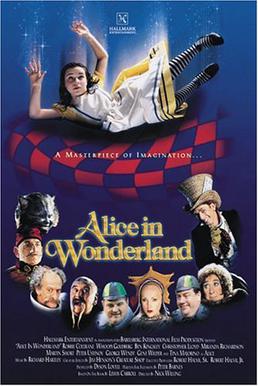
Alice in Wonderland is a 1999 made-for-television film adaptation of Lewis Carroll's books Alice's Adventures in Wonderland (1865) and Through the Looking-Glass (1871). It was first broadcast on NBC and then shown on British television on Channel 4.

Alice in Wonderland is a 1903 British silent fantasy film directed by Cecil Hepworth and Percy Stow. Only one copy of the original film is known to exist. The British Film Institute (BFI) partially restored the movie and its original film tinting and released it in 2010. According to BFI, the original film ran about 12 minutes; the restoration runs 9 minutes and 35 seconds. At the beginning of the restoration, it states that this is the first movie adaptation of Lewis Carroll's 1865 children's book Alice's Adventures in Wonderland. It was filmed mostly at Port Meadow in Oxford.

Lewis Carroll's books Alice's Adventures in Wonderland (1865) and Through the Looking-Glass (1871) have been highly popular in their original forms, and have served as the basis for many subsequent works since they were published. They have been adapted directly into other media, their characters and situations have been appropriated into other works, and these elements have been referenced innumerable times as familiar elements of shared culture. Simple references to the two books are too numerous to list; this list of works based on Alice in Wonderland focuses on works based specifically and substantially on Carroll's two books about the character of Alice.

The Looking Glass Wars is a series of three novels by Frank Beddor, heavily inspired by Lewis Carroll's 1865 novel Alice's Adventures in Wonderland and its 1871 sequel Through the Looking-Glass. The premise is that the two books written by Lewis Carroll are a distortion of the "true story".
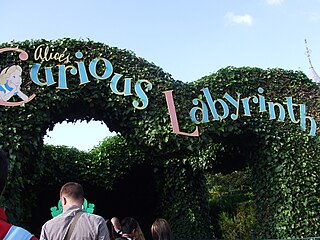
Alice's Curious Labyrinth is a hedge maze attraction at the Disneyland Park within Disneyland Paris. It opened in 1992 with the Park, and belongs to the British part of Fantasyland. A similar maze attraction, based on both the 1951 and 2010 Disney film adaptations of Lewis Carroll's Alice in Wonderland, exists at Shanghai Disneyland Park.

Alice's Adventures in Wonderland is a 1972 British musical film directed by Australian filmmaker William Sterling, based on Lewis Carroll's 1865 novel of the same name and its 1871 sequel, Through the Looking-Glass. It had a distinguished ensemble cast and a musical score composed by John Barry with lyrics written by Don Black. In addition, make-up artist Stuart Freeborn created film visuals based on the original drawings by John Tenniel from the first edition of the novel.

Alice in Wonderland is a dark ride in Fantasyland at Disneyland in Anaheim, California. Based on the 1951 animated Disney film of the same name, the attraction resides next to a second ride, the Mad Tea Party, based on a scene in that same adaptation.

The Dormouse is a character in "A Mad Tea-Party", Chapter VII from the 1865 novel Alice's Adventures in Wonderland by Lewis Carroll.

The Mouse is a fictional character in Lewis Carroll's 1865 novel Alice's Adventures in Wonderland. He appears in Chapter II "The Pool of Tears" and Chapter III "A Caucus-Race and a Long Tale".
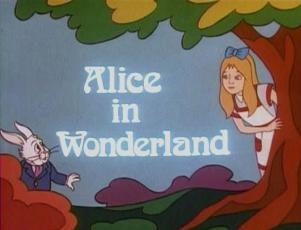
Alice in Wonderland is an Australian 51-minute direct-to-video animated film from Burbank Films Australia originally released in 1988.

Alice in Wonderland is a 1949 French film based on Lewis Carroll's 1865 fantasy novel Alice's Adventures in Wonderland. Directed by Dallas Bower, the film stars Carol Marsh as Alice, Stephen Murray as Lewis Carroll, and Raymond Bussières as The Tailor. Most of the Wonderland characters are portrayed by stop-motion animated puppets created by Lou Bunin.

Alice in Wonderland is a 1915 American silent film adaptation of Lewis Carroll's classic 1865 novel, Alice's Adventures in Wonderland, directed and written by W. W. Young and starring Viola Savoy as Alice.

Alice's Adventures in Wonderland is a 10-minute black-and-white silent film made in the United States in 1910, and is based on Lewis Carroll's 1865 book of the same name.
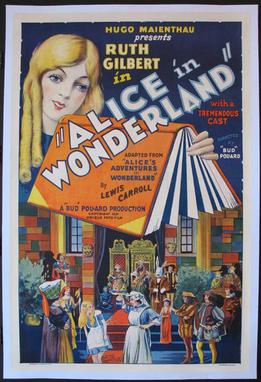
Alice in Wonderland (1931) is an independently made black-and-white Pre-Code American film based on Lewis Carroll's 1865 novel Alice's Adventures in Wonderland, directed by Bud Pollard, produced by Hugo Maienthau, and filmed at Metropolitan Studios in Fort Lee, New Jersey.
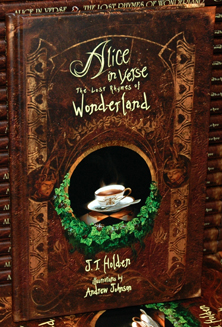
Alice in Verse: The Lost Rhymes of Wonderland (2010) is a reimagining of Lewis Carroll's 1865 novel Alice's Adventures in Wonderland written by British-American author J.T. Holden. It tells the story of Alice's Adventures in Wonderland in 19 rhyming poems, each written in the same style as Lewis Carroll's original verse. The book includes 36 illustrations by American artist Andrew Johnson.

Wonderland is the setting for Lewis Carroll's 1865 children's novel Alice's Adventures in Wonderland.
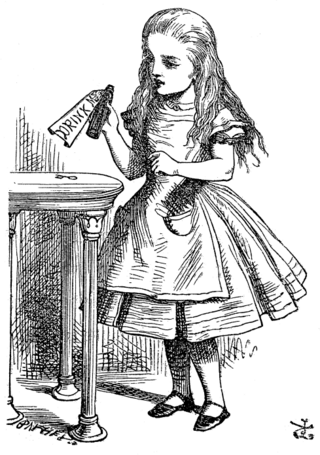
Alice, the main protagonist of Lewis Carroll's novels Alice's Adventures in Wonderland (1865) and Through the Looking-Glass (1871), has been adapted to several media.



















